Fumigation Operations
Structural Fumigation
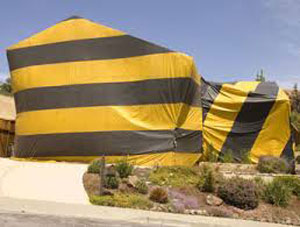
Structural fumigation
(photo: sanjoaquinpestcontrol.com)
Structural fumigation is a pest control method that involves filling the airspace within a structure with a toxic gas. The structure is covered with tarp or tent to keep the gas inside. The gas penetrates cracks, crevices, and pores in the wood to eliminate pests, such as wood-destroying organisms and bed bugs. Fans are used to help the gas escape into the atmosphere. After the tarp is removed, leftover residues are not expected to remain on surfaces.
The primary active ingredient in fumigants intended for residential dwellings is sulfuryl fluoride. Only certified applicators can use sulfuryl fluoride products because the U.S. EPA classifies them as Restricted Use Pesticides (RUP). Certified applicators have been trained in the proper handling of the fumigant and fumigation-related equipment and procedures.
Some basic steps in structural fumigation
- The structure must be sealed with a tarp to trap gas inside during fumigation.
- The structure must be secured and warning signs posted to prevent people from entering the structure during fumigation.
- Because sulfuryl fluoride is a colorless, odorless, and highly toxic gas, chloropicrin (a highly irritating substance) is commonly used as a warning agent to clear people from the structure.
- The tarp is removed and the structure is aerated after fumigation.
- Applicators conduct air monitoring procedures to make sure sulfuryl fluoride levels do not exceed the EPA established limit of 1 part per million (ppm).
- Occupants are not allowed to reenter until the applicator checks are complete.
[return]
Tarpaulin Fumigation
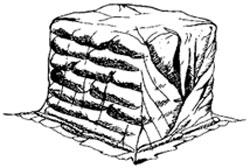
Tarpaulin fumigation (image: fao.org)
Tarpaulins provide the flexibility to fumigate a range of items from a wood borer-infested museum piece to an entire structure. Tarps should be at least 4 mils (0.004 inches) thick and made of gas-impervious polyethylene, vinyl or neoprene-coated nylon, or an equivalent material. Multiple tarps can be joined by overlapping the adjoining edges by at least 12 inches and fastening them with clamps spaced not more than 12 inches apart.
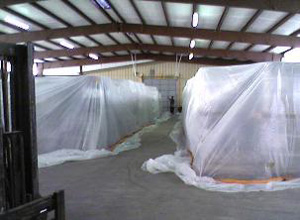
Fumigation on impermeable surface
(photo: pestcontrolcape.co)
Fumigate on an impermeable surface. Concrete paving without cracks or joints is best. If an impermeable floor is not available, place a tarp on the surface, then stack the commodity on top.
Tarps should be large enough to allow an 18-inch lip of material around the base of the enclosure. Be sure that the ends overlap. Seal lips against the floor by piling sand on the exposed tarp. Use "sand or water snakes" around the entire lip. They should be at least 3-inches in diameter and made of canvas or polyethylene tubing. As a final precaution, check tarps tor pinholes, leaks, and tears before use. Pad sharp corners with burlap a soft material to prevent tears. Use care when walking on tarps or using heavy equipment near them.
[return]
Grain and Bulk Commodities
Grain fumigation can be affected by type and condition of the grain: size, shape and permeability of the kernels, and the amount of dockage (fines, dust, etc.) in the grain.
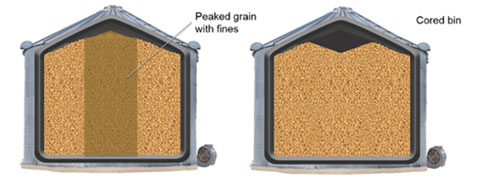
Fines increase potential problems with some stored grain pests and can reduce effectiveness of fumigation. (Photo: info.intellifarms.com)
Sorptive capacity of stored grain refers to adsorption (the adhesion of the fumigant gas molecules to the external surface of the grain), plus absorption (gas molecules held in the kernel). Other factors being constant, the sorptive capacity of a grain increases with a decrease in kernel size and a corresponding increase in surface area. Permeability of seed coat is also a factor. Increased sorptive capacity means less gas fumigant in the surrounding air. As a result, recommended dosages are generally higher for smaller grains such as wheat, rye, or sorghum than they are for corn.
Phosphine gas is an extremely effective fumigant for grain and other commodities, either in bulk or packaged. When fumigating grain, the phosphine gas dosage rate depends on the type of storage, the pests to be controlled, and commodity temperature. As with all fumigations, seal the structure as tight as possible. In some cases, you may have to cover the entire structure with polyethylene or gas-proof tarpaulins.
Phosphine gas has remarkable penetrating and distributing power, therefore, you may not need special recirculating equipment. Simply apply the fumigant directly into the grain mass or the stream of grain as it is conveyed into the silo (elevator). Place the tablets or pellets into the stream of grain by hand or with a dispenser. If the bulk commodity is already stored in a silo, bulk bin, flat storage, etc., insert the fumigant tablets or pellets into the mass with a probe. Fumigant manufacturers also supply these probes.
The recirculation method gives the best results when using phosphine in a grain bin or elevator. This method requires blowers, which are usually located outside at the bottom of the silo or storage building. Ducts connected to the blowers go from the inside bottom to the top of the bin so the air will go down through the grain and recirculate to the top. Recirculation allows gas to penetrate areas that are resistant to natural gravity movement of the gas, thus providing better insect control.
Seal the grain storage facility as air tight as possible before fumigating and ensure that the recirculation system is operating properly. After establishing airflow throughout the grain mass, turn the fans and place the phosphine on top of the grain. Recirculate air until the fumigant is thoroughly distributed. Then, turn off the recirculation system and allow at least a 4-day exposure time.
Aerate the grain by disconnecting the return air duct and operating the ventilation system until exhaust air is free of fumigant traces, as indicated by a gas detector tube or audible alarm. Phosphine can be left in the grain for long periods without adverse effects and this will improve the control. However, aeration is needed if grain is moved soon after fumigation. DO NOT USE detectors that depend on flame around grain elevators. Also, check the grain surface for possible pockets of gas that may not have aerated. The fumigant label will state the exposure time and aeration procedures. The residual dust from the aluminum phosphide pellets or tablets will be removed automatically by the usual handling of the grain. No additional measure is required to render the bulk commodity marketable.
There is a fundamental difference between phosphine fumigation of bulk and packaged commodities. Tablets or pellets are added directly to bulk products. However, neither tablets, pellets, bags, or plates, nor their residues come in direct contact with the goods in packaged commodities.
[return]
Chamber Fumigation
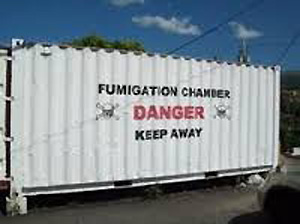
(Photo: dir.indiamart.co)
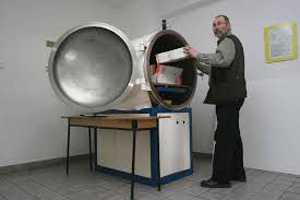
(Photo: dir.indiamart.com)
A fumigation chamber is an example of a tight seal. Little gas escapes from a well-constructed chamber. Compare that to placing a gas-tight tarp over commodities or structures. Tarps can provide a poor-to-excellent seal depending on:
- The condition of the tarp
- The tightness of the seams
- The type of ground seal
Vacuum Chambers
The penetration rate of gas into the material to be fumigated is often an important factor, and is related to the material's sorptive capacity. The product's penetration rate is greatly increased if fumigation is done in an airtight chamber from which the air has been removed. This is vacuum fumigation. You can remove the fumigant quite completely from by drawing a second vacuum after the proper period of exposure to the gas and then breaking this vacuum with air. This process is known as "air-washing". Do NOT use phosphine for vacuum fumigations.
Vacuum fumigation is an advantage when speed is an important factor. The vacuum usually reduces the time necessary to kill insects protected by plant materials (e.g., in baled cotton) to a small fraction of that required under natural atmospheric conditions. However, if the amount of plant material is great, the amount of fumigant needed increases greatly because of increased sorption. Another advantage of vacuum fumigation is that applicators are not exposed to the gas.
[return]
Vehicle Fumigation
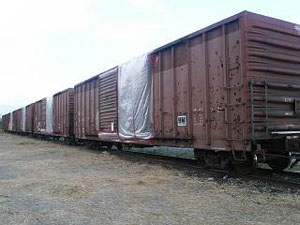
Railcars are the most frequently fumigated vehicles in Kentucky.
(photo: tdc.ca)
Stationary (Static) fumigation is approved for boxcars, hopper cars with covered tops that can be closed and secured, containers, and trucks with permanently enclosed tops. The carrier must remain sealed and stationary for the minimum retention period for an effective kill:
Phosphine & CO2 - 24 hours
CO2 - 96 hours
In-transit fumigation is approved for hatch or trough type hopper cars that have covered tops that can be closed and secured. Boxcars are not approved. Trucks, trailers, containers, and vans are not approved while traveling on public roads; however, these carriers are acceptable if they have permanently enclosed tops, sides, and bottoms, and are transported by rail. Aeration of these carriers is prohibited while enroute.
Railcar fumigation procedure:
 Place cars on a seldom-used track or siding so that they will not have to be moved while under fumigation. Rail cars can only be fumigated with phosphine.
Place cars on a seldom-used track or siding so that they will not have to be moved while under fumigation. Rail cars can only be fumigated with phosphine.
 Carefully seal all car openings. Pay particular attention to the space around doors, the eaves, and the floor.
Carefully seal all car openings. Pay particular attention to the space around doors, the eaves, and the floor.
 Post warning signs conforming to the fumigant label on both doors and on each hatch on top of the cars before applying the fumigant.
Post warning signs conforming to the fumigant label on both doors and on each hatch on top of the cars before applying the fumigant.
 After fumigation, open all doors and vents to allow as much air circulation as possible.Thirty (30) minutes is usually required to aerate a car after fumigation but this must be determined using a gas detector. Keep all persons out of the area during fumigation and aeration and until the gas detector shows that no fumigant is present. Only then is it safe to enter the car without wearing respiratory protection.
After fumigation, open all doors and vents to allow as much air circulation as possible.Thirty (30) minutes is usually required to aerate a car after fumigation but this must be determined using a gas detector. Keep all persons out of the area during fumigation and aeration and until the gas detector shows that no fumigant is present. Only then is it safe to enter the car without wearing respiratory protection.
[return]
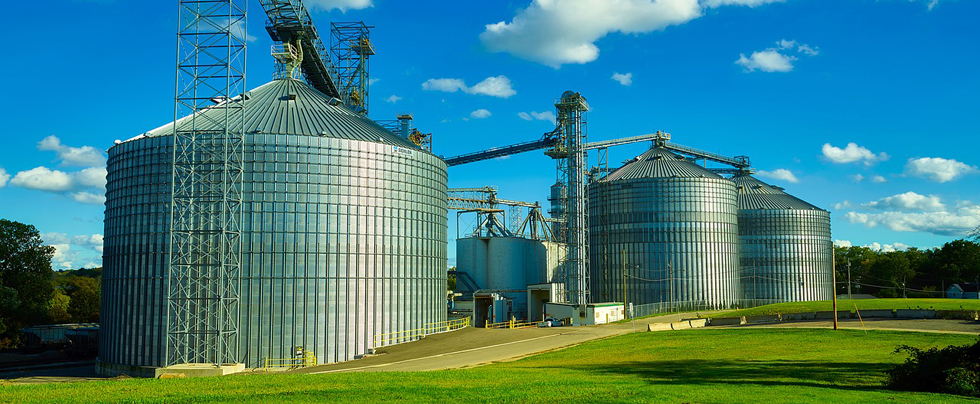








 Place cars on a seldom-used track or siding so that they will not have to be moved while under fumigation. Rail cars can only be fumigated with phosphine.
Place cars on a seldom-used track or siding so that they will not have to be moved while under fumigation. Rail cars can only be fumigated with phosphine.